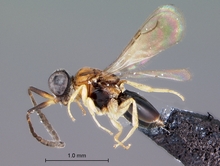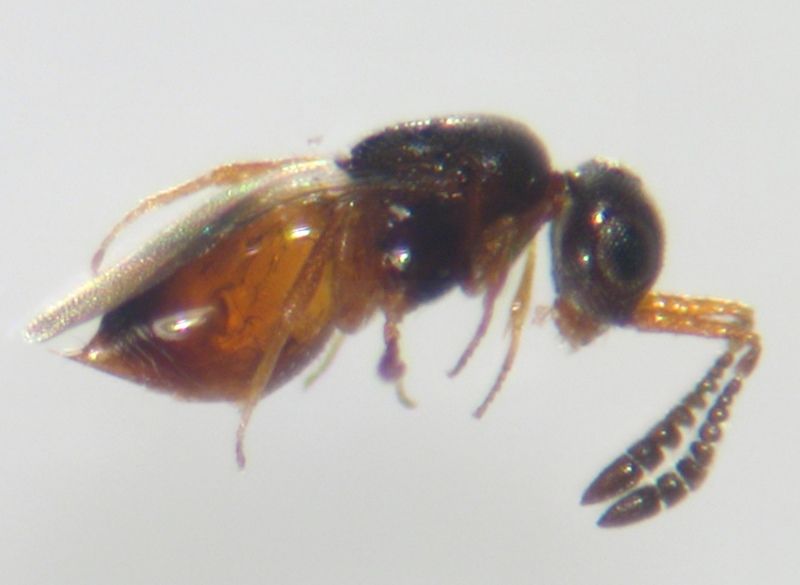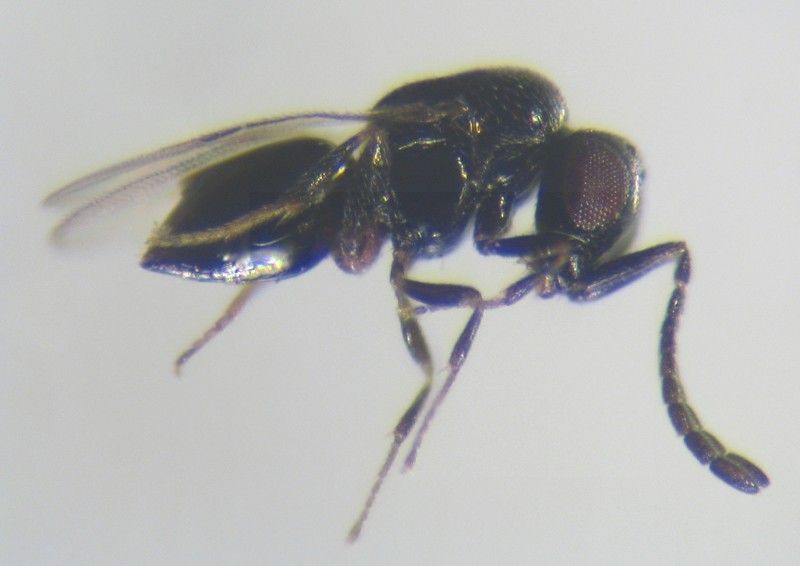Ceraphronidae
Ceraphronidae
The Ceraphronidae are a family of Hymenoptera global distribution. There are over 300 known species, spread over 15 genera.
Features
There are small animals of less than one to a maximum of about five millimeters body length. They are usually colored black, but there are also brown, orange-brown and yellowish color prior (often on the abdomen ). The antennas have a strongly elongated basal joint, the rest of the antenna sits it with a significant angle to ( " gekniete " antennas). The scourge is usually quite short and often somewhat thickened clavate to the top, but they can also be long and filiform. The number of segments can differ depending on the species, the males always have a segment more than the females. Often there are ten or eleven segments. The antennas sit just above the clypeus about equal to the lower edge of eyes, so relatively deep, at. Largest mouthparts are the bicuspid mandibles.
The animals can be winged, kurzflügelig ( brachypterous ) or wingless. Often, the training wing is variable within a species, the females are wingless, although frequently. The wings are always clear with a narrow Flügelmal ( pterostigma ) in the forewing, they are tight with little hairs ( Mikrotricha ) occupied. The Flügeladerung is greatly reduced. In the forewing is only one core visible (as Costa or fused Costa / Subcosta or interpreted as fused Costa and radius), which runs as a boundary wire to Flügelmal, but is separated from it by a small interruption. Usually it sits towards the tip a small, hook-shaped extension to (interpreted as either a radius or cross vein R -RS). The Flügelmal is narrow and inconspicuous. The little hind wing usually has to no veining.
Characteristic of the family is the number of spurs (strong, thorn -like spikes ) to the tibia ( rails ). Here sit one at the Vordertibien two, at the Mitteltibien and the Hintertibien again two spurs. The species of the superfamily Ceraphronoidea are the only waist wasp species with two spurs at the Vordertibien. The Spurs are comb-shaped cut ( pectinate ). On the fuselage also falls on the greatly shortened pronotum. In the middle segment ( mesonotum ) sit in contrast to the related family Megaspilidae, no striking, paired keel lines (as Notaulices or Parapsiden referred ) ( Exception: Ceraphron abnormis ). Sits on the abdomen as striking a special education field glands of unknown function at the top of various abdominal segments (usually on tergite 6), referred to as " Waterston's organ ". The abdomen is rounded usually relatively short and to the sides, the first free segment is the longest. The ovipositor of the female is mostly hidden from moderate length and at rest in the abdomen.
Way of life
All Ceraphronidae are other than larval parasitoids insects. Many species are obligate parasitoids of other Hymenoptera, which are parasitoids themselves, which means they are Hyperparasitoide. Always be infested species in envelopes or wrappers, but may not be very massive. The larva of Ceraphronidae lives freely on their host ( ectoparasitoid ), which is generally occupied only in the last larval stage or during pupation with an egg. Well studied and also of economic importance is the genus Aphanogmus. You parasitized larvae of parasitic wasps of the genus Aphidius (Family Brackwespen, subfamily Aphidiinae ), which in turn parasitize itself in aphids. The Aphidius larva eats the last stage the aphid complexion of their exoskeleton surrounds an empty shell ( " Blattlausmumie " ) the verpuppenden parasitoids. At this stage the Aphanogmus - female lays its egg by the Blattlausmumie through to the parasitoids. It possibly also already occupied by a hyperparasite animals are occupied, so that the animals are then hyperparasite second order, but this is not the rule. The Aphanogmus larva goes through three instars and pupate in the Blattlausmumie next to the remains of their host. Since the Ceraphronide parasitized a parasitoid, which in turn affects a aphid, which may be economically significant as pests, they decreased as all hyperparasite the effectiveness of biological control.
Other Ceraphronidenarten are primary parasitoids. So kick some species ( including other representatives of Aphanogmus ) as parasitoids of gall midges ( Cecidomyiidae ) that they occupy within their gall with an egg.
System
The Ceraphronidae are one of two families of the superfamily Ceraphronoidea. My sister group relationship with the second family Megaspilidae is considered well secured. The Ceraphronoidea are traditionally classified into a large and ill-defined lineage of Hymenoptera, which is referred to as Proctotrupomorpha. These small, often very similar to each other animals are poorly studied; it is believed that more than nine-tenths of the actually existing species are still undescribed. They are often informally summarized as " Mikrohymenopteren ". In addition to the placement in the Proctotrupomorpha, possibly as a sister group of the Platygastoidea, a position within the Evaniomorpha (hunger wasp -like ) is being considered.



.jpg)






